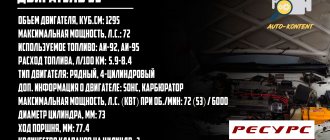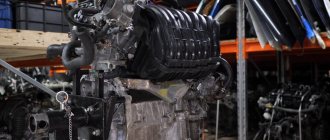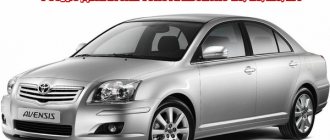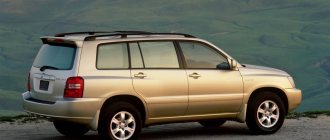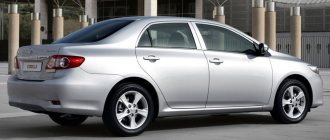The Toyota Corolla class C passenger car is produced by a well-known automobile corporation from Japan. The brand first appeared in 1966 and has since gained popularity all over the world. The Corolla car became the best-selling brand on the planet in 1997, thanks to which it was included in the Guinness Book of Records. The Japanese model managed to surpass the Volkswagen Beetle. In less than half a century, sales volume exceeded 39 million cars. Over the years, Corolla has undergone many changes along the way of improvement.
The name of the model translated from Latin means “small crown”. Toyota Corolla, in addition to Japan, is produced in Canada (Ontario, Cambridge), Brazil (Indaiatuba, Sao Paulo), India (Bangalore), China (Tianjin), England (Derbyshire), Australia (Victoria), Venezuela, Turkey, Thailand, Taiwan, South Africa, Philippines, Pakistan, Malaysia and Indonesia. In the United States of America (California, NUMMI), production of this brand ended in 2010.
The Toyota Corolla chassis and engines are coded “E”, which means they belong to the Corolla family. At first these were mainly rear-wheel drive cars, then cars with all-wheel drive and front-wheel drive appeared. Almost immediately after its appearance on the market, this model began to compete with the Nissan Sunny.
The first Toyota Corolla was born in 1966. The brand had rear-wheel drive, the engine was located longitudinally. A special feature of the car were the round headlights. This arrangement remained until 1984. This year, the first Corolla equipped with front-wheel drive appeared on the automobile market.
From its birth to 1997, the car was produced in five body styles:
- station wagon;
- liftback;
- five-door hatchback;
- three-door hatchback;
- sedan.
Toyota Corolla 1966 in 2014
The fifth generation of the model, which appeared in 1984, retained rear-wheel drive for the station wagon and three-door hatchback, while other variants received front-wheel drive. In 1987, the sixth generation of this car with an E90 body appeared on the automobile market. Despite the obsolete design, excellent anti-corrosion coating and excellent build quality have turned this generation into one of the most popular in the world. The eighth generation of Corolla launched in 1997. The EE110 body was presented in the following varieties:
- station wagons;
- three-door liftbacks;
- five-door liftbacks;
- sedans.
Toyota Corolla engines were classics of world mechanical engineering.
Modifications of popular cars
The Corolla sales center was first called Toyota Public Store in Japan. Toyota Publica cars were offered to customers here. The Corolla car began to be sold almost at the same time as the rebadged Sprinter brand. Over the years, there have been high-quality additions: the twins Sprinter Marino and Corolla Ceres (hardtop), sports versions of the Sprinter Trueno and Corolla Levin.
Toyota Corolla FX GT
Under the Toyota brand, the Corolla FX with a hatchback body was released. This brand later became known as Corolla RunX. Then the Corolla ZZE128 appeared on the market. The Corolla Verso minivan was originally intended for the European market. This model has a variant for Japan - Corolla Spacio, the production of which has been suspended since the tenth generation.
A variation of the Corolla, Rumion, is known in America as the Scion xB. North American marketers launched the Toyota Corolla Matrix on the E140 and E120 platforms. Toyota Australia produced the Corolla TE72 station wagon. In Australia, the five-door station wagon was sold on the automotive market as the Corolla Seca. The name has traditionally been transferred to new generations of five-door models.
Toyota's first model with front-wheel drive was the Corolla Tercel, which rolled off the factory assembly line in 1980. After some time, the Corolla II with a hatchback body appeared on the Tercel base.
The service life of the Toyota Corolla engine ensured good speed, reliability and a long period of operation.
How long do the engines run on a Toyota Corolla?
As a rule, both engines pass the first 250 thousand kilometers without any significant problems. The main thing is to change the engine oil on time. The manufacturer recommends changing the lubricant every 10 thousand kilometers. But, as practice shows, in order to maintain the performance characteristics of the car and extend the engine life, it is best to carry out a scheduled replacement every 7.5-8 thousand km.
Common malfunctions of 1ZZ, 3ZZ, 4ZZ-FE motors:
- Increased oil consumption. It is observed mainly among power plants manufactured before 2002. The problem lies in the oil scraper rings, which are best replaced with a 2005 model or newer ones. Add oil to the level, after which the problem disappears;
- Increased noise, knocking of the 1ZZ engine. It occurs at the turn of the first 150 thousand km, and is solved by replacing the timing chain. Valves on Toyota Corolla engines knock in rare cases and do not need frequent adjustment;
- RPM instability can be resolved by flushing the throttle valve and idle air valve;
- Vibration often occurs on some engines, and it is not always possible to eliminate it. You need to check the rear engine mount.
If we compare power plants of different generations in terms of resource, then, of course, engines of the 3ZZ, 4ZZ series significantly outperform the older modification 1ZZ. They can be bored and sleeved, which is a definite plus. But 1ZZ engines often refuse to be serviced, they are practically impossible to overhaul, or carrying out such work turns out to be an unprofitable exercise. It is for this reason that many domestic car enthusiasts do not like 1ZZ power plants.
E10, first generation
Toyota Corolla Body E10
The presentation of the first Toyota Corolla car took place in the Land of the Rising Sun in October nineteen sixty-six. The model with a ninety-inch wheelbase was intended for sale on the domestic market. It was equipped with rear-wheel drive according to the usual classical scheme.
The prototype was equipped with a motor whose displacement was less than a liter. In those years, larger displacement Japanese engines brought increased taxes for the manufacturer. The company nevertheless decided to increase the most important indicator. The longitudinally mounted K engine had a displacement of 1.1 liters and a power of seventy-three horsepower. It ran on gasoline and could reach speeds of up to one hundred thirty-five kilometers per hour.
Three years later, the company increased the engine volume to 1.166 liters. This decision benefited the car: it was readily bought. The engines could be equipped not only with a single-chamber, but also with a two-chamber carburetor. For a 1.1 liter engine – a K-V carburetor, for a 1.3 liter – 3K-V. If compared with single-chamber ones, the increase in power actually amounted to 13 horsepower. For that time this was a significant increase. Both engines had four cylinders and eight valves. The transmission could be either a two-speed automatic or a four-speed manual.
The Toyota Corolla Sprinter model appeared on the automobile market two years after its first presentation. It was made in a fastback body and was offered to customers only through the Toyota Auto Store, the company's dealership in Japan.
Toyota Corolla 1.6 engine cylinder head
The cylinder head is a pastel for two camshafts with “wells” in the center for the spark plugs. The valves are arranged in a V-shape. A special feature of this engine is the presence of hydraulic compensators. That is, you won’t have to adjust the valve clearance again. The only problem is associated with the use of low-quality oil, in which case the channels may become clogged and the hydraulic compensators will cease to perform their function. In this case, a characteristic unpleasant sound will come from under the valve cover.
E20, second generation
Toyota Corolla body E20
In 1970, in May, the first version of the E20 appeared, the second generation Corolla with a wheelbase of 91.9 inches. The body of this model has become more streamlined, the dimensions have increased slightly. Unlike the first generation, this version was presented to customers in two versions. The engine capacity of one of them, the OHV-1400T, was 1.4 liters with a power of ninety horsepower. The volume of another engine, OHV-1600 2T, is 1.6 liters, and the power is first one hundred and two horsepower, later increased to one hundred and fifteen horsepower. Accordingly, the cost also differed. From this year, the production of Sprinter and Corolla was already distinguished by finishing and metal processing methods. In March 1972, an improved version of the Corolla Levin appeared, equipped with a 2T engine with 2 camshafts. There were no changes to the suspension; the lights, radiator grille, turn signals and headlights were different. Body corrosion protection turned out to be at a low level, so sales decreased.
In Australia, the second generation was presented by the KE20 station wagon, equipped with a 3K engine, and a two-door sedan. These models had a single brake system with drums at the rear and brake pads at the front. In New Zealand, the KE20 model, a four-door Corolla, appeared on the car market.
E30, E40, E50, E60, third generation
Toyota Corolla E30 body
The debut of the third generation in April 1974 coincided with the oil crisis. Demand for the Corolla, especially in the United States, began to grow as it was a practical and economical model. For the first time in the history of the family, the company has become a leader in terms of production volume of these machines.
The body indexes of cars sold in different countries differed significantly:
- in Japan - E30, 35, 36, 37, 50, 51, 52, 53;
- in Europe – E30;
- in the USA - E31, 37, 38, 51;
- in Australia - KE30, 35, 38, 55.
The E51 and E50 indices were used for brands with a liftback body, while the E60 and E40 indices were used to sell the Toyota Sprinter. The most affordable modification of all is a two-door sedan equipped with a 3K engine, which had a volume of 1.2 liters with a power of fifty-five horsepower and a standard manual transmission-4. The rear suspension has undergone changes, springs have appeared instead of springs. Engine power was reduced due to the installation of a catalytic converter.
The most common engines of 1.2 and 1.6 liters produced power of 55 and 75 horsepower, respectively. In a number of countries there was a 1.3-liter engine with a power of 60 hp. The 2T-G engine (1.6 l, 124 hp) was sold in Japan. The body remained unstable to corrosion. A little later, four-door sedans appeared on the market.
1UZ-FE
1UZ-FE is a reliable four-liter engine for the Toyota Celsior, and was later also installed on the Crown, Aristo, Soarer and 2 more cars in the Lexus line. Toyota engineers modified the 1UZ 2 times to reduce its weight and increase horses. They succeeded, since the latest engines in this line are slightly superior to their predecessors in almost all respects.
Due to the fact that 1UZ-FE has been modified twice, its technical characteristics will depend on the specific modification. But if you look, in general, this is an 8-cylinder engine, the horsepower of which varies from 256 to 290, depending on the modification. The fuel compression ratio can also be from 10.0 to 10.5. The mileage with proper maintenance reaches at least 500 thousand km. Despite the large engine capacity, fuel consumption looks quite economical, 7-9 liters per 100 km for the highway and 14-16 liters for the city.
With proper maintenance, the engine will serve its driver for a long time. Timely replacement of the timing belt and spark plugs, high-quality oil and the use of original components will push back the cap. repair for a long time. At the same time, the engine has attachments and associated components that may lose their functionality ahead of schedule.
It is difficult to find any shortcomings in the 1UZ-FE; they are often related to the age of the motor or improper maintenance. Perhaps the only disadvantage of the engine is that the owner will have to fill up with at least 95 gasoline, but in the future this will more than pay off, since thanks to high-quality fuel the engine will last a long time.
For 1UZ-FE, the first step is to install a compressor based on Eaton M90. It is also worth buying a direct-flow exhaust. Then the engine will be able to develop power up to 330 hp. This tuning method is the most popular among Toyota lovers. If you want even more power in the engine, then you can install new pistons, connecting rods, injectors and studs. Then the engine power can reach 400 hp.
E70, fourth generation
Toyota Corolla body E70
The 4th generation model appeared in 1979, when approximately 2,300 of these cars were produced in one day. A sales record was set in Japan.
The 3T-S engine (1.8 l, 76 hp) appeared for the US market. In 1983, it was replaced by a more economical 4A-C engine with an aluminum cylinder head (1.6 l, from 70 to 90 hp). After him, the corporation began to use aluminum BC heads. The 1.2 liter engine was replaced with another (1.3 liter, 65 hp). The gearbox was not changed at first. A four-speed automatic appeared in 1982.
The brake mechanisms at the front became disc. An anti-roll bar has been added to the front suspension. New features include power steering and power brakes. Since 1981, round headlights have become rectangular.
E80, fifth generation
Toyota Corolla E80 body
The presentation of the fifth generation took place in May 1983. Five-door hatchbacks and sedans appeared on the market. In 1984, another five-door hatchback was created for the European market. The engines remained the same, as did the manual gearbox-5. The automatic transmission could have not only four, but also three steps.
For the first time they began selling cars with a diesel engine (1.8 liters, 58 hp). They made the rear wheel suspension independent. The drive became front-wheel drive. For the first time on a Corolla, the engine was placed transversely. The sports models used a 1.6-liter 4A-GE engine with a power of up to 130 hp. With. The station wagon with all-wheel drive was sold only in the USA.
Rear suspension design
Other technical characteristics are also at a high level. It would seem that the suspension design is elementary, but it provides high conditions of comfort, reliability and long-term operation. The front struts have been familiar to us for a long time; they are MacPherson struts with good technical characteristics. It was decided to use a torsion beam in the rear suspension.
This “simple” suspension has earned a lot of good reviews from its owners. Its high technical performance adequately and adequately withstands all the vicissitudes of domestic roads.
Toyota Corolla 2007, 2008 and 2009 was equipped with all possible and necessary systems under operating conditions that meet and ensure safety for all road users. This includes active and passive safety systems. For example, the basic configuration includes ABC+EVD, emergency braking amplifiers are installed, and front and side airbags are also required.
For cars with the "Elegance" package, in addition to what was said above, they are additionally equipped with curtain airbags and airbags for the drivers' knees. According to the conclusions of experts and the results of tests, this particular model deserves the highest safety ratings. Due attention has also been paid to pedestrian safety.
E90, sixth generation
Toyota Corolla body E90
The debut of the sixth generation took place in May 1987. Only modifications with front-wheel drive or all-wheel drive remain. The engines remained both carburetor and injection. The 4A-GE engine (1.6 l) was modernized in 1990, which made it possible to increase its power to 135 hp. With. In Europe, the 1C diesel (1.8 l) was popular, the power of which increased to 67 hp. With.
All Corollas have independent suspension, but the station wagon had a continuous rear axle. In 1989, a sedan was equipped with all-wheel drive for the US market. Everywhere the service of Japanese brands is at a good level.
The best engines of the third wave
The third wave dates back to the late 1990s. Past models are giving way to innovative developments of the ZZ, AZ, NZ series. Cylinder blocks began to be made from light alloys. It is believed that this is a “disposable” design. The gas distribution was already with variable phases, and the timing drive was chain, not belt. ETCS, an advanced throttle control system, also appears.
These are 4-cylinder petrol power units. The following positions are considered the best:
- 1ZZ-FE;
- 2ZZ-GE;
- 4ZZ-FE;
- 1AZ-FE;
- 2AZ-FSE;
- 1NZ-FXE;
- 2NZ-FE.
All engines have an aluminum cylinder block, a chain drive and cast iron liners to move the pistons.
E90, seventh generation
Toyota Corolla 1993
The seventh generation was introduced by the company in 1991. The car has become more dynamic and larger. The most popular engines are 7A-FE 1.8 liters and 4A-FE 1.6 liters. In Japan, sports versions with power up to 168 hp were sold. With. In Europe - only injection engines and naturally aspirated diesel 2C with a power of 72 hp. With.
A three-door hatchback with all-wheel drive and a 7A-FE engine (1.8 liters, 118 hp) was considered a powerful brand. There were only Corolla station wagons and sedan versions on the market in the United States.
E110, eighth generation
Toyota Corolla body 1995
In May 1995, the corporation introduced the eighth generation. Technically the car has not changed. In 1997, the interior and exterior were slightly updated. In Europe, the car was awarded the title “car of the year”.
The rally car was equipped with a 3S-GTE engine and an all-wheel drive transmission. Since 1999, the ZZ-FE series of motors has been introduced. In the USA, the 1ZZ-FE engine has gained particular popularity in the Toyota Avensis.
The best engines of the first wave
The peak of Toyota's production of the most productive engines was between 1990 and 2010. Motors of this period were most often subject to criticism, discussion, review and controversy. In addition, the company itself actively collected reviews about its products from car owners, experts and car repair specialists.
However, the development of Toyota motor technology is usually divided into several waves. And here the story begins much earlier.
The first wave occurred from 1970 to the early 1980s. Nowadays, such engines of the R, V, M, T, Y, K, A and S series can only be found among collectors, in a landfill or in a museum.
However, the engines of the first wave were already striking in their unpretentiousness and durability. Series A and S engines were installed in popular cars such as Corolla/Sprinter 90-110, Corona/Carina/Caldina 170-210.
E120, E130, ninth generation
Toyota Corolla 2001
The ninth generation started in 2001 in Frankfurt. The new brand was specially developed for Europe. There are quite a few body styles: a high-capacity station wagon, a sedan, three- and five-door hatchbacks, and just a station wagon. There was a new product with a 1.8 liter engine producing 192 hp. With. and manual gearbox-6 (Toyota T-Sport). The diesel engine received a power supply system.
In 2004, moldings, optics, bumpers were updated, and airbags appeared on the side. This generation is still in demand on the used car market.
Peculiarities
Released in 2008, the model inherited all the best from previous versions. Its performance and driving characteristics are at the highest level. The following features are especially worth highlighting:
- Spacious interior;
- Modern and high-quality suspension;
- Excellent handling;
- Improved security system.
Thanks to its reliability and excellent technical equipment, the car has received numerous recognition among a huge number of car enthusiasts.
E140, E150, tenth generation
Toyota Corolla 2008
The most popular car on the planet was destined to become the representative of the tenth generation. Forty million copies sold. The car has become wider and longer, more economical and comfortable. Body rigidity has increased. The basic version has 15-inch wheels.
In the USA they sell cars with 1.8 liter petrol engines. One is 2ZR-FE (132 hp) and 2ZR-FAE, which has a Valvematik system and has increased compression (140 hp). In America, there is a choice of gearboxes between a six-speed manual and a five-speed automatic.
The base engine in Europe is Dual-VVTi (1.33 liters of gasoline, 99 hp). The second is a motor of the same design (1.6 l, 122 hp). New in Europe is the CVTi-S (Multidrive) variator.
E160, eleventh generation
Toyota Corolla Axio
Sales of these models began in May 2012 on the Japanese market. Sedan - Corolla Axio, station wagon - Corolla Fielder. The sedan with the 1NR-FE series engine has a volume of 1.3 liters, and 1NZ-FE - 1.5 liters. The engines have four cylinders.
The modifications are equipped with a CVT transmission (continuously variable) and a five-speed manual transmission. The brand with all-wheel drive and a 1.3-liter engine is available only with a continuously variable transmission. Corolla Fielder is sold on the market with a 1.5 liter or 1.8 liter engine and a continuously variable transmission. The first version comes with all-wheel drive and front-wheel drive, the second has only front-wheel drive.
E170 for Europe
Toyota Corolla body E170
The production of the next generation of the legendary Toyota Corolla XI model on European assembly lines began in 2013. Despite this fact, the car officially belongs to the 2014 model year and bears a special body index E170.
The Corolla car presented on the Russian market is equipped with three types of gasoline engines, differing in power and cylinder capacity. In Toyota technical documentation they are assigned the following indices: 1NR-FE (cylinder volume 1329 cubic mm, power 99 hp or 73 kW), 1ZR-FE (cylinder volume 1598 cubic mm, power 122 hp or 90 kW) and 2ZR-FE (cylinder volume 1798 cubic mm, power 140 hp or 103 kW).
All engines have the same architecture: two camshafts in the head (DOHC - Double Over Head Camshaft), four valves per cylinder, plus the original Dual VVT-i valve timing control system. The material of the blocks is a special aluminum alloy, from which, among other things, the walls of the wells are made.
Corolla E170 cars with the 1NR-FE engine are equipped with a 6-speed manual transmission.
The 1ZR-FE engine on the Russian market will mainly be offered for Corolla models with a 6-speed manual transmission, but its symbiosis with the Multidrive S CVT is optionally possible.
There is only one transmission for the 2ZR-FE engine - a conventionally “seven-speed” variator.
What is this car?
Europe first saw a modification of this model in 2007. It should be noted that the hatchback of this model received its own name - Auris. The tenth version of this model, the anniversary one, greatly transformed its entire appearance. She gained more solidity and style.
The changes made by the developers to the appearance of the car made it look like expensive sedans. Sometimes it seems that it is larger than it actually is.
The standard basic equipment of this model is called “comfort”. It is understood that this option will have air conditioning and front windows. Headlight glass washers are installed in the front bumper. The front seats, as well as the front mirrors, are equipped with heating systems. The car is equipped with central locking and an immobilizer. There is a modern car radio.
The equipment called “Elegance” rises somewhat higher. In it, to everything that was listed earlier, a power window is added to the rear doors, which operates in automatic climate control mode. The radio gets additional speakers. The steering wheel is covered in leather and equipped with keys that control the audio system and front fog lights.
The richest “prestige” equipment brings the car to the level of a high level of equipment. Such models are equipped with alloy wheels, light and rain sensors. A button to start the engine appeared in the cabin. Not without installing cruise control and an electrochromic rear view mirror.
READ MORE: Technical characteristics of Toyota Fielder
The swift appearance of this model is enhanced by its length, which is 130 mm longer than its predecessor. Starting from 2007, it began to be produced 50 mm wider, and the roof pillars became narrower. All this taken together made her interior more spacious and comfortable.
The model's interior received wider doorways and a new design of car seats, which added even more comfort to the car. The interior is decorated only with high-quality materials. Two color types of finishing are used, these are dark gray and light beige tones.
By increasing the headroom and legroom for passengers in the rear seats, discomfort when traveling long distances has disappeared.
The luggage compartment of the Toyota Corolla, which was produced in 2007, 2008 and 2009, has been significantly expanded. The cabin is equipped with several places to store small items.
